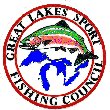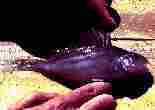

 TO CONTROL RUFFE
TO CONTROL RUFFEStocking Duluth harbor with native predator fish was a technique employed to help control the Eurasian ruffe. It made anglers happy by providing more sportfish, but Sea Grant researcher Derek Ogle discovered that it didn't do much to control the growth or spread of this exotic fish during the years of his study (1989-1991).
One idea was that walleye and northern pike, might eat the ruffe and act as a natural population control. To give these native predators an advantage, thousands of young fish were stocked in the St. Louis River estuary and tight angling limits were imposed, which are still in place today.
Ogle found that northern pike were eating only a few ruffe and that walleye were not eating any. "In our three-year study we looked at about 1,100 walleye stomachs and didn't find a single ruffe," said Ogle. Most other predators were eating some ruffe, but they made up only a small percentage of their diets. Bullheads appeared to be the primary consumers of ruffe.
"It looks like predators might not be an effective control of the initial invasion of the ruffe, at least for the first years they are exposed to them," Ogle said.
The National Biological Service in Ashland, Wis. is conducting follow-up studies to determine whether predation is increasing as the ruffe population expands and native fish become more used to the idea of ruffe in their diet.
Kathy Mayo, NBS in Ashland, Wis., recently found ruffe in walleye stomachs, which means predators will eventually eat ruffe. However, her research also shows predators seem to prefer other prey over ruffe.
